Rabbits
Rabbits
Proper Care
Needs
Here’s a simple checklist to assist you in taking proper care of your rabbit
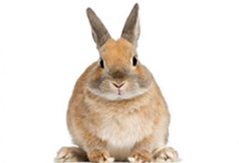
- Water bowl / bottle
- Food bowl
- Cage
- Bedding
- Litter box with litter
- Nail clipper
- Grooming supplies (e.g. brush, comb)
- Chewing blocks (for trimming of teeth)
- Toys
- Access to clean and fresh water
- Adequate and nutritious food
- Registered veterinarian consultation for regular checkups or medical treatment when the rabbit is sick / injured
Above all, remember your rabbit needs tender loving care!
Feeding
What food to feed and how much to feed?
Rabbits are herbivores. This means they only eat grass, vegetables and fruits. Grass hay and vegetables form the best diet as timothy hay may not be available. Some shops sell timothy hay, it is important to look for fresh and not moldy hay. The main staple foods for a pet rabbit should be grass hay and fresh green vegetables. If you want to give your rabbit a tiny amount of rabbit alfalfa pellet, remember to choose pellets that have high fibre content and those without nuts, seeds, dried fruits, coloured pieces and grains as they contain high level of salt and sugar which are not healthy for your rabbit and may cause it to become obese. Older rabbits may need less pellets and more hay and green.
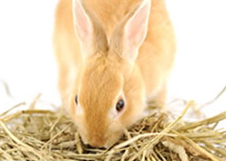
In addition, you can follow the feeding instructions on the packet of quality pellets for the appropriate amount to feed. Make sure you don’t feed your rabbit more than it needs, otherwise it will become overweight and may suffer as a result.
You should also give your rabbit a variety of fresh green vegetables each day. Some recommended vegetables include kale, bok choy and celery. To provide calcium for your rabbit, feed it hard vegetables such as broccoli (stems and leaves mainly) and cauliflower. Sweet vegetables such as carrots and fruits contain a relatively high level of sugar, so only offer your rabbit a thin piece as an occasional treat.
Rabbits can be creature of habit in terms of food. When you purchase or adopt a rabbit, be sure to bring home some food the rabbit has been eating. The rabbit should be given transition time should there be change of diet.
Make sure you provide your rabbit with clean, fresh water at all times. Fill water in a heavy water bowl made of stainless steel or ceramic to prevent tipping or use a commercial water dropper that can be hung on the cage. Be sure the tip of the water dropper is well-positioned for your rabbit to reach easily. Replace water bowl or water dropper with clean, fresh water daily. Keep the containers hygienic.
Rabbits have teeth that grow continuously therefore make sure you provide your rabbit with a chewing block for it to chew and gnaw on to prevent overgrowth. If your rabbit is reluctant to eat or drools, it may be a sign that it has overgrown teeth. Bring it to a vet clinic for consult as the teeth may need to be trimmed by a vet.
Is it ok to give my rabbit treats?
Most packaged treats contain high levels of sugar and salt which are not healthy for your rabbit and can cause tooth problems and obesity. So it’s best to avoid giving your rabbit packaged treats. If you would like to offer your rabbit a treat, give it a small amount of fresh fruits or fresh vegetables instead.
What kind of food bowl to use?
It’s best to use heavy food bowls made of stainless steel or ceramic to avoid spillage. Plastic ones are too light and flimsy and are likely to be picked up and tossed about by rabbits. Make sure you wash your rabbit’s food bowl frequently.
What is coprophagia in rabbits and other rodents?
Rabbits form two types of fecal pellets. The soft and moist type contains high level of vitamin B and K and higher protein level. The rabbit eats these droppings directly from anus to redigest the nutrient.
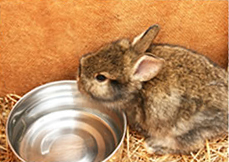
Accommodation and exercising
Rabbits in hot tropical climate should live indoor and be kept cool and shaded. They should be kept in a spacious playpen setup or in a cage that is big enough to fit a hide-away (covered area for hiding and resting) or a hidey box, food and water bowls, a litter box and still has room for your rabbit to take three hops from end to end. Put a chewing block in the cage for your rabbit to chew on. You should provide a cage that is made of non-chewable material, such as metal or hard plastic, and one with a door that opens from the side instead of from the top, this way, your rabbit can run into or be herded back into its own cage instead of being handled and put back into the cage. The floor of the cage should be solid. Avoid cages with wire floors as they are uncomfortable for rabbits and can hurt their feet. If you have to use a wire-floored cage, cover the base with newspaper, corrugated cardboard, thick layers of straw or shavings. The bedding should be changed daily.
Just like humans, rabbits need regular exercise to stay healthy. Therefore, you should provide supervised exercise and play is encouraged. Rabbits love to chew so rabbit-proof* your flat. Keep household plants and electric wire out of reach of your rabbit.
Never confine your rabbit in a cage exclusively as this could lead to abnormal elimination habits, behavioural problems, feet inflammation, obesity problems, poor bone density and poor muscle tone.
Give your rabbit a litter box filled with clean litter so that it can go to toilet. Rabbits urinate and defecate heavily and tend to use a certain place as toilet. Put the litter box in the corner your rabbit has chosen. You can get rabbit litter from pet shops. Throw away all used litter, wash the box with a mild detergent and refill clean litter into the box once a day.
* It means keeping harmful chemicals (such as washing powder, bleach, etc.) and food and substances that are poisonous for rabbits out of reach of your rabbit.
Cleaning and grooming
Rabbits are meticulous groomers. They often clean their own fur, therefore they do not need a bath. You can use mild soapy water and a towel to spot clean dirty patches that your rabbit cannot reach or clean itself. You can also use baby wipes (those without alcohol) to clean their claws if they are really dirty. For short-haired rabbits, they only require grooming during heavy shredding periods, brush them gently with a soft brush. For long-haired rabbits, brush them regularly with a soft brush.
During shredding periods, feed your rabbit with a thin slice of pineapple or papaya tablets to prevent hairballs.
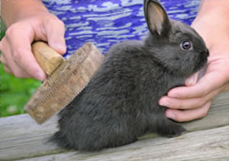
Trim your rabbit’s nails every 6 weeks or as necessary. If you are unsure how to do this then consult your vet for instructions. Be extra careful when you cut your rabbit’s nails as you can easily cut through the blood vessel in the centre of the nail (it’s called the quick). Under ample lighting, the quick should be clearly visible unless the nail is black. Have styptic powder nearby to stop the bleeding in case you cut the quick.
Interaction
Rabbits are sociable animals that thrive on attention and social interaction. They will love your company. Therefore, play with your rabbit every day and give it lots of attention, love and time. You can talk to it calmly and stroke it gently daily. Some rabbits are affectionate and will nuzzle or lick their handlers. Others are shyer and require longer time to socialise or bond with human. So try to socialise with your rabbit daily especially when it’s young so that it feels comfortable around people. To calm your rabbit, stroke it between its eyes, over the top of its head and down its back gently and slowly.
You may also consider getting your rabbit a friend as rabbits often crave the companionship of their own kind. It’s best to get two female rabbits, as two male rabbits will tend to fight. Opposite gender will allow unwanted breeding.
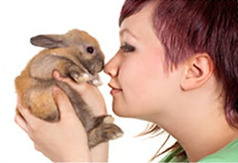
Rabbits need firm but gentle handling from an early age. Start this by sitting on non-slippery floor. Pick up your rabbit gently by placing one hand under its chest and the other hand supporting its bottom. Never pick up your rabbit by its ears. Once you have picked it up, hold it comfortably and securely against your chest or on your lap. If it struggles to get down once lifted, lower yourself and the rabbit as close to the ground as possible to avoid falls and injuries. Do not force your rabbit to be held if it is struggling against you as it may break its backbone while trying to get away from you. Be aware that rabbits have powerful back legs and strong claws; they can kick out and scratch if they feel scared.
Rabbits are prey animals, which mean they are naturally afraid of anything coming down from above to grab them. So make sure you take things slowly before picking up your rabbit. Allow the rabbit to come to you and sniff you on its own terms. When it comes to you, give it a treat and then a few gentle strokes, then try to pick it up gently. The more you handle your rabbit, the quieter and friendlier it will be.
Training
Rabbits can be litter trained. They can also be taught to come to you when you call their name.